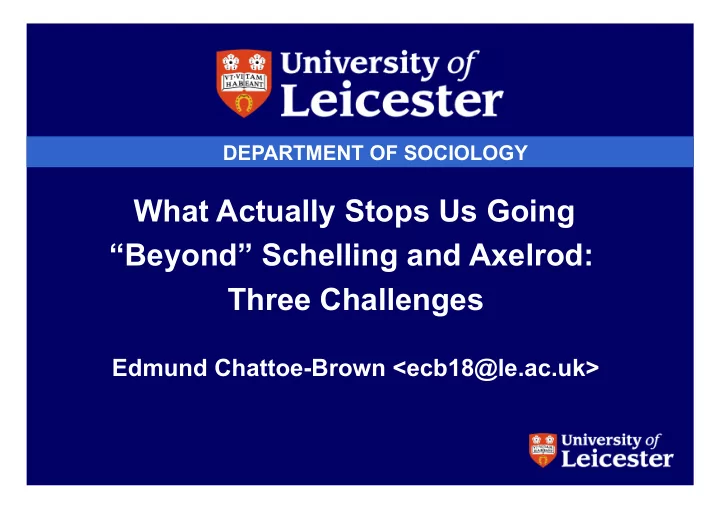

DEPARTMENT OF SOCIOLOGY What Actually Stops Us Going “Beyond” Schelling and Axelrod: Three Challenges Edmund Chattoe-Brown <ecb18@le.ac.uk>
1. Plan • Sorry: Really has to be just a taster for other work in progress. • What kind of thing is ABM? • Challenge 1: Element selection. • Challenge 2: “Heaps of ABM”. • Challenge 3: Research design. • Conclusions.
2. Caveats • One of the difficulties is that people don’t really write this stuff down so it can be properly scrutinised/criticised. • The development of ABM is inevitably part of wider trends and historical contingencies in the academy.
3. What kind of thing is ABM? • Hypothesis: ABM is a research method (compare statistics or ethnography). • Corollary: It needs a methodology. • It has one for empirical ABM (calibration and validation: see Gilbert and Troitzsch and Hägerstrand). • But if it is used in other ways, there still has to be a way of evaluating it beyond “fan clubs” or it isn’t “science”. How do we impartially evaluate a “thought experiment?” Did Schelling actually discover anything about ethnic segregation?
4. Challenge 1: Element selection • How do we justify having (not having) a social network structure in a “Schelling type” model? • In a sense once you have identified an ABM, calibration and validation is relatively straightforward. • What seems plausible to one discipline may seem equally implausible to another. Can this issue be resolved without data? IMO unlikely.
5. Some possible solutions • Synthesis of existing approaches: Suits ABM but still problematic without data? KISS? • “Switchable” models: Models that differ only in an element to inform “how much difference it makes” and perhaps even “what kind of difference”. (See unpublished draft paper.) • “Modular” interdisciplinarity: Different disciplines take ownership of different aspects (but must listen to other potential contributors). Lovely if it works. I will go to the celebration on my flying pig. • Modelling competitions with the same raw material? • Just recognising the issue?
6. Challenge 2: “Heaps of ABM” • We already know what happens if we don’t address this issue: Very large numbers of non-commensurable, non- empirical and “not implausible” ABM. • Can we decide in a “scientific” way if one non empirical ABM is “better” than another? IMO no. • Danger of twiddling models to produce “arbitrary” outputs like opinion polarisation (which may themselves not be soundly empirical). Best empirical example of PD? • Chattoe-Brown (2014): The very popular Zaller-Deffuant model looks nothing like real opinion data (turning points).
7. Possible solutions • If I were you I wouldn’t start from here at all: Only ABM that are validated (and ideally calibrated too) can be progressive. • What do we make of having an example of this methodology from 1965 (Hägerstrand) that is very rarely cited? Later examples too: Kalick and Hamilton, Abdou and Gilbert. • Methodology here is clearly describable procedures to rank models by validation and calibration status. (See submitted draft chapter.)
8. Challenge 3: Research design • To make life trickier, these challenges are connected. • We have to say what we want to “prove”. (Compare “greater wealth is associated with greater educational success” or “doctors start with a best guess diagnosis based on obvious symptoms and then disconfirm by “experimental” intervention”.) • Compare “how do I use an ABM to prove the theory of cognitive dissonance is coherent?” and “how do I use an ABM to prove the theory of cognitive dissonance is correct?” • In published ABM, look for comparisons of real and simulated data, substantive uses of empirical research and explicit claims for evaluating the model. Good luck!
9. Possible improvements • Make better use of existing research design ideas. Inter-coder reliability: Do two independent ABM from the same “raw material” come out the same? • Related ideas from statistics (over fitting, mis-specification, equi-finality): How discriminating can a two type Schelling model really be?
10. Two asides on data • Housing complaints (Rossi 1955): Amount of closet space (33%), open space about the house (28%), street noise (23%), amount of room (22%), heating equipment (16%), rent (15%), nearness to friends or relatives (15%), amount of air and sunlight (14%), kind of people around here (13%) , amount of privacy (12%), nearness to church (9%), travel to work (8%), kind of schools around here (6%), shopping facilities (6%). • From 129 articles containing the search term <agent- based> in the journal Social Networks , 6 were validated and arguably none were also calibrated.
11. Conclusions • Taking the methodology (or perhaps methodologies) of ABM seriously gives us a way forward to “ranking” models. Without this, we can certainly proliferate ABM but it is not clear we can progress them. • While it may be cosy/easy to be hazy about what we are aiming at and how we prove we succeeded, this may harm ABM except among those who are already converts.
12. Fin • Questions? • Comments? • Criticisms?
13. Now read on • Abdou, M. and Gilbert, N. (2009) ‘Modelling the Emergence and Dynamics of Social and Workplace Segregation’, Mind and Society , 8 (2), December, pp. 173-191. • Chattoe-Brown, E. (2014) ‘Using Agent Based Modelling to Integrate Data on Attitude Change’, Sociological Research Online , 19 (1), February, <http://www.socresonline.org.uk/ 19/1/16.html>. • Chattoe-Brown, E. (2017) ‘Why Questions Like “Do Networks Matter?” Matter to Methodology’, draft paper. [Available from the presenter.] • Chattoe-Brown, E. (2017) ‘Agent-Based Modelling’, draft paper. [Available from the presenter.] • Gilbert, N. and Troitzsch, K. (2005) Simulation for the Social Scientist , second edition (Milton Keynes: Open University Press). • Hägerstrand, T. (1965) ‘A Monte Carlo Approach to Diffusion’, Archives Europe/ennes de Sociologie , 6 (1), pp. 43-67. • Kalick, M. and Hamilton, T. (1988) ‘Closer Look at a Matching Simulation: Reply to Aron’, Journal of Personality and Social Psychology , 54 (3), March, pp. 447-451.
Recommend
More recommend